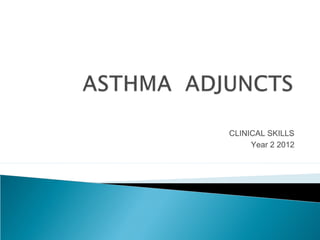
Asthma adjuncts
- 1. CLINICAL SKILLS Year 2 2012
- 2. At the end of this session, the student will be expected to: Define peak expiratory flow and interpret PEF readings for adults and children on charts Describe how to use a peak flow meter, used in assessment of lung function in patients eg to assess the presence and reversibility of bronchospasm, and in monitoring of patients on therapy Be able to explain the use of a metered dose inhaler to a patient commencing inhaled treatment for the first time Be able to explain the indications for and use of a spacer device
- 3. Simplest, quickest and cheapest test of lung function. Often the only one available in general practice. PEF is the maximum rate of air, expressed in litres per minute, which the patient forcibly exhales in 10 milliseconds, starting from full inhalation. When the airways narrow, PEFR (peak expiratory flow rate) falls.
- 4. Predicted PEF For each patient, predicted peak flow is worked out from a chart of predicted values for patients of similar characteristics (ht, age ,sex, race and wt). In adults, this depends on their sex, age and height. We can then compare the actual PEF of the patient with the predicted PEF. In children a predicted peak flow measurement depends on height until the age of approximately 10 or11yrs, when gender is then taken into consideration too (puberty -> increased strength). Results nearest to 100% of the predicted value are the most normal, and results over 80% are often considered normal.
- 7. Explain and demonstrate to the patient what he is required to do: i.e. take a deep breath in, then blow out as hard and fast as possible into the peak flow meter, with the lips sealed firmly around the mouthpiece. The best of 3 attempts is recorded. (Note-the peak flow meter has a disposable mouthpiece, which is changed prior to use by each patient)
- 9. Use of MDI's transformed asthma management, particularly with regard to the role of steroids in asthma. They have overcome the serious toxic effects that were previously experienced with prolonged oral steroids. Standard MDI's are the most widely used delivery system as they are both effective and easily portable. Used to administer corticosteroids e.g Becotide, bronchodilators (Beta-stimulants e.g Astavent=Salbutamol) and anti- cholinergics (e.g Atrovent). Important to note, a 4mg Salbutamol tablet produces an equivalent effect in the lungs to 200mcg of inhaled Salbutamol, but the risk of side-effects e.g. headaches, tremors or GI disturbance is directly proportional to the overall dose, hence the inhaled route is infinitely better. Disadvantage - The technique of inhalation is difficult especially in the elderly, young children less than 5yrs of age and in arthritic patients.
- 10. 1) Explain the procedure to the patient and demonstrate what is to be done so as to ensure the patient gets the full benefit of the treatment. 2) Check expiry date. 3) Shake well. 4) Hold upright. 5) Co-ordinate inhalation with pressing the canister down. 6) Wait a few seconds before the next inhaled metered dose.
- 12. Many different spacer devices available. Principle of spacers is that the medication is ejected into the chamber before the patient inhales. Gives several advantages over the standard metered dose inhaler: 1) No need to co-ordinate actuation of the canister with inhalation. Hence suitable for use in children and patients with poor inhalation technique. 2) No direct impact of cold aerosol particles on the back of the throat, makes some people on MDI's cough or gag. 3) Larger drug particles, which otherwise get deposited in the mouth and throat, are instead deposited in the chamber. Hence reduces incidence of oral thrush ( Candidiasis) in patients on inhaled steroids. Spacers are best suited for patients who receive all their treatment at home e.g. the elderly and young children- They are fitted with a mouthpiece or a facemask for very young babies.
- 15. National Asthma Guidelines (KEH Asthma Clinic) Illustrations from the National Respiratory Training Centre, Warwick Latest updates by Drs Reina Abraham/ Matthews and clinicians 2012
- 16. Oxygen therapy Nebulisation Basic airway management Adult endotracheal intubation
